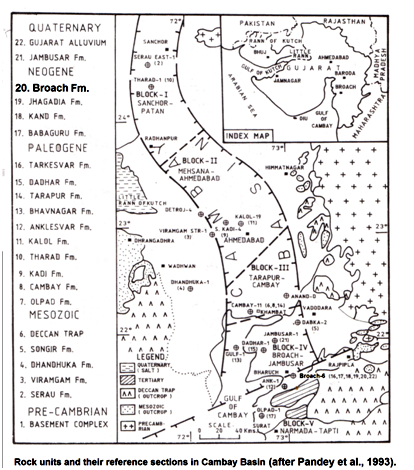Broach Fm
Type Locality and Naming
SUBSURFACE: Well Broach-6 (depth interval 800-1728 m), 928 m thickness [Original Publication: Chandra, P.K. and Chowdhary, L.R. (1969) Stratigraphy of the Cambay Basin, ONGC Bull., vol. 6 (2), pp. 37-50.]. Reference well: i) Pakhajan-1 (depth interval 831 – 1680 m); ii) Siswa-1 (depth interval 322 – 634 m); iii) Nawagam-22 (depth interval 255 – 402 m), In Pakhajan-1 the thickness is 849 m while in Siswa-1 and Nawagam-22, the thickness is 312 m and 147 m.
Lithology and Thickness
Sandy claystone. In the type section, the formation consists of alternations of chocolate brown to reddish-brown claystone, sandy claystone and sandstone. In reference section, the formation consists of alternations of brown to reddish-brown claystone and sandstone. The maximum thickness has been encountered in the type section which is 928 m in Broach-6. The thickness in reference section i.e. Pakhajan-1, Siswa-1 and Nawagam-22 is 849 m, 310 m and 150 m.
[Figure 1: Rock units and their reference sections in Cambay Basin (after Pandey et al., 1993)]
[Figure 2: Generalized stratigraphy of the Cambay Basin. (from Jaiswal and Bhattacharya, 2018, J.EarthSyst.Sci., 127:65)]
Relationships and Distribution
Lower contact
The lower boundary is unconformable with the Jhagadia Fm.
Upper contact
The upper boundary is conformable with the Jambusar Fm.
Regional extent
The restricted deposition of the formation in the areas to the north of the Narmada river was caused by strong, syn-sedimentary negative movements in the Broach depression. Along the Narmada fault, or its southern extension, it was subsequently removed by erosion.
GeoJSON
Fossils
The common faunal assemblage of the formation includes species of Bolivina, Elphidium, Nonionella, Cibicides, Quinqueloculina and Rotalia.
Age
Depositional setting
Additional Information

